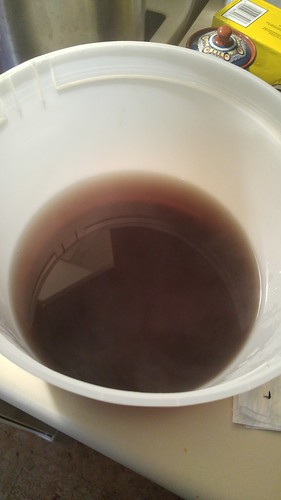Today's post is about my first attempt at dyeing yarn with lupines. They grow thick and beautiful here in the late spring/early summer. I spent a lovely evening gathering a bunch of it the other night with a friend, and have gathered more since to freeze for future dyeing days.
I only collected the flower stalks, and used only the flowers for the dye bath. If you had to guess what colour that would produce, you'd probably guess blue or purple. You'd be wrong.
While the dye bath was a lovely burgundy/pink shade, the yarn initially came out looking a sad shade of greyish-green after steeping overnight. I was disappointed, but figured I'd overdye it with something else. I toss the first dip yarn into a bath with pH neutral wool wash and an extra skein into the dye bath to exhaust the dye. I left for work and left it be. When I got home, the exhaust bath yarn was a paler sad shade of greyish-green when I pulled it out and into a rinse bath. So imagine my surprise when I reached into the wool wash bath and pulled out a skein of lime green yarn!
 |
| First dip yarn on left, exhaust bath yarn in middle, undyed yarn on right. |
For a bit of background here, I used Briggs and Little Sport yarn, divided into 25 g skeins for experimentation. I premordent the yarn with alum, with cream of tarter as an assist. I forgot to rinse the yarn before moving it from the premordent pot to the dye bath, and I thought that was why the dye seemed so disappointing. I suspect that my water isn't a pure as I'd like. I'll probably have to get bottled water to get more control of my results.
 |
| I already have a couple baskets worth of yarn in the freezer for future dyeing! |
Have you tried natural dyeing yet? I'm fascinated with the chemistry behind it, and have been consuming all of the books I can on the matter. Know of any good ones to recommend?




Wow, fascinating! I don't know much about dyeing (other than messing around using onion skins and lichen, when I was a kid) but will be following your progress with great interest.
ReplyDeleteThanks! It's a lot of fun. I'm so curious about everything now - I walk around staring at things wondering if they'd be a good dye plant. :D
DeleteNot a knitter personally, so I've never tried yarn dyeing, but I've maintained a fascination with the colour of food lol. Ever since I was a little girl I've marveled at the bright juices coming out of cherries or beets, and I've wondered if I could dye my fabric with them! Very interesting post and I look forward to seeing your future experiments.
ReplyDeleteYou could try dyeing fabrics too with the same plants! :) I'm focused on yarn right now, but I've wondered about dyeing with fabric too.
DeleteI love that shade of green! Never dyed yarn so I will be reading what you do and how your results are with great interest.
ReplyDeleteGod bless.
Thanks! I was so happy to see what colour appeared. It's just lovely, eh?
DeleteThat is so damned pretty!
ReplyDeleteThanks! <3
DeleteOh, Heather, I'm so excited that you're doing this. I often see indigo dyeing kits and think of your indigo experiment. It was so great. I do want to try dyeing stuff from my garden. I planned to plant a dye garden, in fact, but things came up and I just tended the plants I already had. A few of those would probably produce something, but I got lazy with the whole thing.
ReplyDeleteIf I did dye naturally, I'd like to solar dye in old giant pickle jars I have in the garage. Solar dyeing seems most appropriate for lazy peeps.
I cannot wait to see more of your results. This one experiment gave you a gradient set! This sounds like a perfect side project in your line of work and with your adventurous spirit.